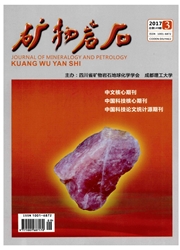

 中文摘要:
中文摘要:
通过薄片鉴定、扫描电镜和阴极发光观察对饶阳凹陷沙河街组碎屑岩储层的22口探井864个薄片样品的碳酸盐胶结物进行期次划分,再据各期胶结物的共生矿物研究、碳氧同位素分析、流体包裹体测温等对其形成机制进行研究。研究结果表明研究区共发育3期碳酸盐胶结物:第一期以粒状方解石为主,其形成于岩石充分压实之前的早成岩阶段,伴生少量的黄铁矿胶结;第二期以粒状细晶级为主,多发育方解石、白云石,以斑块状以及嵌晶式连生方式赋存,与前期的胶结物之间常形成一层黏土薄膜;第三期以柱状或粒状细晶级形式存在,以方解石、白云石、铁方解石以及铁白云石成分为主,充填长石等易溶性颗粒溶孔及交代早期碳酸盐胶结物。据胶结物碳氧同位素分析恢复古盐度Z值及测算古地温判断早期胶结物来源于古盐度较高的淡水成因流体;再根据胶结物流体包裹体均一温度判断方解石胶结物形成于中成岩A期,为有机酸脱羧基生成大量CO2,使化学平衡向着生成碳酸盐的方向移动,表示其“碳”来源为有机碳。对储层质量影响方面,早期碳酸盐胶结物增加了砂体的抗压实能力,对研究区储层质量的影响是正面的,而中后期碳酸盐胶结物充填长石及岩屑溶蚀作用形成的孔隙,对储层质量的影响是负面的。
 英文摘要:
英文摘要:
The forming stages of carbonate cements of 864 thin sections from 22 drilling wells in Shahejie Formation are classified by thin section identification, scanning electron microscopy and cathodoluminescence analysis. And the forming mechanism of the carbonate cements is studied on the basis of analysis of coexisting minerals, carbon and oxygen isotope and homogeneous tempera- ture of fluid inclusions of each period of carbonate cements. It shows that there are three stages of carbonate cements. The first stage is dominated by granular calcite, which is formed in the early diagenetic stage before the rock is fully compacted,accompanied by a small amount of pyrite ce- ment. The second stage is mainly fine-grained calcite and dolomite developed in poikilitic and spot forms,and clay film often occurs between the first stage and second stage cements. The third stage is columnar or granular in shape,fine-grained calcite, dolomite, iron calcite and iron dolo- mite,and these cements filled in dissolved pores such as feldspar and metasomatic early stage car- bonate. According to the carbon and oxygen isotope analysis of the carbonate cement,the ancient salinity (Z) is restored and the paleo temperature is calculated. It reveals that the early cement is resulted from fresh fluid with high salinity and the calcite cement is formed in the mid-diagenetic stage A according to the homogeneous temperature of the fluid inclusions. For organic acid is de- carboxylated to generate large amount of CO2 ,the chemical equilibrium shifts towards the direc- tion of generation of carbonate, indicating that the carbon is originated from organic carbon. In terms of reservoir quality, early stage carbonate cements increase the compaction resistance of the sand bodies, has a positive effect on reservoir quality. While mid-late stage carbonate cements filled in feldspars and dissolution pores plays negative effect on reservoir quality.
 同期刊论文项目
同期刊论文项目
 同项目期刊论文
同项目期刊论文
 期刊信息
期刊信息
